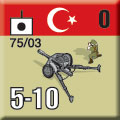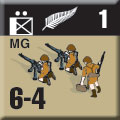Palestine 1916-1918:
Designer’s Preview
by Mike Bennighof, Ph.D.
January 2024
 We set the first two large Infantry Attacks games on the Eastern Front in 1914, but I always intended to expand the series scope to encompass the entire war, much like its sister series, Panzer Grenadier. And so, we have Infantry Attacks: Palestine 1916-1918, taking the series to the Middle East as British Empire forces try to invade the Ottoman Empire against tough resistance. We set the first two large Infantry Attacks games on the Eastern Front in 1914, but I always intended to expand the series scope to encompass the entire war, much like its sister series, Panzer Grenadier. And so, we have Infantry Attacks: Palestine 1916-1918, taking the series to the Middle East as British Empire forces try to invade the Ottoman Empire against tough resistance.
Palestine is a large game; that’s made necessary by the wide array of Imperial forces the British deployed in the campaign. I designed the game sort of backwards, writing the scenarios first and then putting together the mix of pieces (usually, I do things the other way around).
The game plays differently than previous games in the series; the terrain is wide open, but infantry doesn’t march any faster. There are not a lot of places to hide, so any advance is going to be subject to artillery fire for a long time. Yet there’s not much artillery, compared even to the 1914 Eastern Front games (the British set-piece assault on Gaza forming an exception to this). All of that means that cavalry (and camelry!) has actual battlefield value.
 The campaign, like many in the First World War, took no one by surprise. After the Turks failed to capture the Suez Canal, the British advanced into the Sinai Peninsula, meeting Turkish resistance. Palestine 1916-1918 picks up the action in August 1916 with the Battle of Romani in the Sinai. Water supplies dictated how long either side could operate in the desert, eventually forcing the Turks back inside Ottoman-ruled Palestine. The British overcame this difficulty by stealing the rails the Turks had laid across the Sinai Desert to build their own railroad heading in the opposite direction, with a water pipeline alongside. When they finally invaded Palestine, the Turks knew they were coming. The campaign, like many in the First World War, took no one by surprise. After the Turks failed to capture the Suez Canal, the British advanced into the Sinai Peninsula, meeting Turkish resistance. Palestine 1916-1918 picks up the action in August 1916 with the Battle of Romani in the Sinai. Water supplies dictated how long either side could operate in the desert, eventually forcing the Turks back inside Ottoman-ruled Palestine. The British overcame this difficulty by stealing the rails the Turks had laid across the Sinai Desert to build their own railroad heading in the opposite direction, with a water pipeline alongside. When they finally invaded Palestine, the Turks knew they were coming.
 Ottoman resistance stiffened once the fighting crossed the Empire’s border, and the Turks – actually Palestinians of the 20th Infantry Division, the heroes of Gallipoli – repelled two British attacks on Gaza, in March and April 1917. Stalemate settled in, but a new British commander, Edmund Allenby, brought new energy along with reinforcements. After months of preparation, including an overhaul of medical services to stamp out the diseases that had put so many Allied soldiers in hospital, Allenby unhinged the Turkish position by attacking its southern end at Beersheba in early November, and moved quickly to assault all of its strongpoints including Gaza. Ottoman resistance stiffened once the fighting crossed the Empire’s border, and the Turks – actually Palestinians of the 20th Infantry Division, the heroes of Gallipoli – repelled two British attacks on Gaza, in March and April 1917. Stalemate settled in, but a new British commander, Edmund Allenby, brought new energy along with reinforcements. After months of preparation, including an overhaul of medical services to stamp out the diseases that had put so many Allied soldiers in hospital, Allenby unhinged the Turkish position by attacking its southern end at Beersheba in early November, and moved quickly to assault all of its strongpoints including Gaza.
 A British attempt to mislead the German/Ottoman command by planting false battle plans in a dropped satchel, the work of Lt. Col. J.D. Belgrave (noted fraudster Richard Meinertzhagen would later claim credit for the operation, after Belgrave was killed in action), had little effect - the German command recognized the plans as fraudulent. But Allenby’s careful preparations brought an Allied victory anyway. With the former Ottoman front line disintegrating and falling back, Allenby pursued and captured Jerusalem in December 1917. After a pause for the winter rains, Jericho in the Jordan Valley east of Jerusalem fell to the Australian Light Horse and New Zealand Mounted Rifles. The campaign continued after that, but that’s more action than we could fit into the game and we’ll have to conclude the action in an expansion book to carry on the campaigns through Judea, the Jordan Valley and into Syria. A British attempt to mislead the German/Ottoman command by planting false battle plans in a dropped satchel, the work of Lt. Col. J.D. Belgrave (noted fraudster Richard Meinertzhagen would later claim credit for the operation, after Belgrave was killed in action), had little effect - the German command recognized the plans as fraudulent. But Allenby’s careful preparations brought an Allied victory anyway. With the former Ottoman front line disintegrating and falling back, Allenby pursued and captured Jerusalem in December 1917. After a pause for the winter rains, Jericho in the Jordan Valley east of Jerusalem fell to the Australian Light Horse and New Zealand Mounted Rifles. The campaign continued after that, but that’s more action than we could fit into the game and we’ll have to conclude the action in an expansion book to carry on the campaigns through Judea, the Jordan Valley and into Syria.
 Each of those stages of the campaign gets its own chapter, with historical background, scenarios that help advance the narrative as well, and then a battle game that ties the scenarios together. It makes for a game tightly tied to the story, and it’s the sort of game I’ve always wanted us to produce at Avalanche Press. All of our Infantry Attacks games follow this format, and we’ve been converting all of our Panzer Grenadier games to it as well. Palestine has 42 scenarios in six chapters. Each of those stages of the campaign gets its own chapter, with historical background, scenarios that help advance the narrative as well, and then a battle game that ties the scenarios together. It makes for a game tightly tied to the story, and it’s the sort of game I’ve always wanted us to produce at Avalanche Press. All of our Infantry Attacks games follow this format, and we’ve been converting all of our Panzer Grenadier games to it as well. Palestine has 42 scenarios in six chapters.
Infantry Attacks, just by the nature of the conflict simulated, is a simpler game system than Panzer Grenadier. The first games included no aircraft or motor vehicles; the first tanks appeared in Devil Dogs, with special rules to cover them. Palestine includes the one platoon of British Mark I heavy tanks that took part in the unsuccessful Second Battle of Gaza.
 Units are companies in Infantry Attacks, rather than platoons, so you can only put two of them in one hex instead of the three platoons of Panzer Grenadier. There aren’t nearly as many support weapons, so you’re going to be conducting a lot of infantry attacks (see what we did there?) with some machine guns to back them up (not nearly as many as you think you’ll need) and artillery that’s powerful but just not all that responsive (this being the First World War and all). Units are companies in Infantry Attacks, rather than platoons, so you can only put two of them in one hex instead of the three platoons of Panzer Grenadier. There aren’t nearly as many support weapons, so you’re going to be conducting a lot of infantry attacks (see what we did there?) with some machine guns to back them up (not nearly as many as you think you’ll need) and artillery that’s powerful but just not all that responsive (this being the First World War and all).
Palestine includes a whole bunch of new pieces: 605 of them, die-cut and silky-smooth. It needs a lot of them because there are a lot of armies fighting for Palestine. The Allied side includes British, Indian, Australian and New Zealand forces, plus the legendary Bikaner Camel Corps. For the Central Powers, most troops are Ottoman Turks but they have a handful of Bedouin allies plus small German and Austro-Hungarian expeditionary forces. The Turks also have some pretty tough stormtroopers.
 August 1914 included cavalry action and Fall of Empires had even more battles on horseback. Palestine has plenty of action of horseback, with the British Empire bringing plenty of horsemen from all over (Australia, New Zealand, India) and the Ottomans fielding both regular cavalry and Bedouin irregulars. The ANZAC horsemen mostly fight dismounted – but not always, as we all know from the movie version. August 1914 included cavalry action and Fall of Empires had even more battles on horseback. Palestine has plenty of action of horseback, with the British Empire bringing plenty of horsemen from all over (Australia, New Zealand, India) and the Ottomans fielding both regular cavalry and Bedouin irregulars. The ANZAC horsemen mostly fight dismounted – but not always, as we all know from the movie version.
Both sides also have camelry, which is new to Infantry Attacks, and on the battlefield performs like slow cavalry, who actually can charge. Their value comes off the game board, as they can get to places where the horses can’t, thanks to their desert hardiness. Even with the aid of German and Austro-Hungarian batteries, the Ottoman side is desperately short of artillery. Their infantry is actually quite good, but they are usually fighting in a depleted state while facing full-strength enemies.
 All else being equal, I probably would have chosen a different topic for this game, but I’m glad we did it. It stretches the Infantry Attacks game engine, which shows itself as adaptable as its Panzer Grenadier ancestor without a major load of special rules to cover a new situation. It’s colorful, with many nationalities in play, and it has that story-arc format with rich history woven into the narrative. I’m not sure there are many who care about that, but I do. All else being equal, I probably would have chosen a different topic for this game, but I’m glad we did it. It stretches the Infantry Attacks game engine, which shows itself as adaptable as its Panzer Grenadier ancestor without a major load of special rules to cover a new situation. It’s colorful, with many nationalities in play, and it has that story-arc format with rich history woven into the narrative. I’m not sure there are many who care about that, but I do.
Click here to join the Gold Club.
See your Gold Club Insider newsletter for ordering information.
Sign up for our newsletter right here. Your info will never be sold or transferred; we'll just use it to update you on new games and new offers.
Mike Bennighof is president of Avalanche Press and holds a doctorate in history from Emory University. A Fulbright Scholar and NASA Journalist in Space finalist, he has published a great many books, games and articles on historical subjects; people are saying that some of them are actually good.
He lives in Birmingham, Alabama with his wife and three children. He misses his Iron Dog, Leopold. Leopold enjoyed gnawing his deer antler and editing Wikipedia pages.
Want to keep Daily Content free of third-party ads? You can send us some love (and cash) through this link right here.
|
